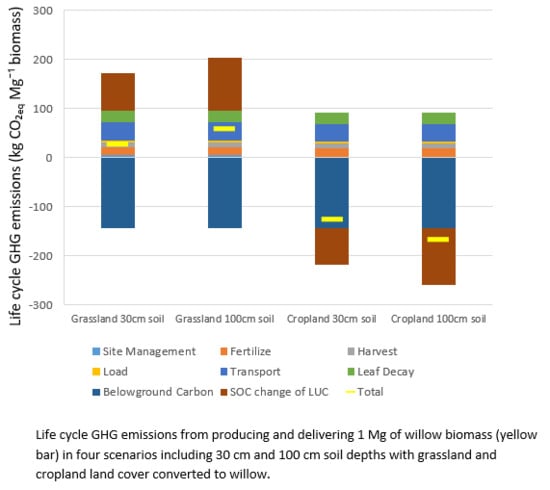Willow Biomass Crops Are a Carbon Negative or Low-Carbon Feedstock Depending on Prior Land Use and Transportation Distances to End Users
Abstract
1. Introduction
2. Materials and Methods
2.1. Scope of LCA and Life Cycle Inventory
2.2. Willow Supply Chain System
2.3. Identification of Suitable Lands for Willow Crops in GIS
2.4. LCA Modeling on Landscape Scales
3. Results
3.1. Baseline LCA Results
3.2. Spatial LCA Results across the Landscape
3.3. Sensitivity Analysis of Life Cycle GHG Emissions
3.4. Uncertainty Analysis of Life Cycle GHG Emissions
4. Discussion
5. Conclusions
Supplementary Materials
Author Contributions
Funding
Acknowledgments
Conflicts of Interest
References
- Caputo, J.; Balogh, S.B.; Volk, T.A.; Johnson, L.; Puettmann, M.; Lippke, B.; Oneil, E. Incorporating uncertainty into a life cycle assessment (LCA) model of short-rotation willow biomass (Salix spp.) crops. Bioenergy Res. 2014, 7, 48–59. [Google Scholar] [CrossRef]
- Rowe, R.L.; Street, N.R.; Taylor, G. Identifying potential environmental impacts of large-scale deployment of dedicated bioenergy crops in the UK. Renew. Sustain. Energy Rev. 2009, 13, 271–290. [Google Scholar] [CrossRef]
- Braun, R.; Karlen, D.; Johnson, D. Sustainable alternative fuel feedstock opportunities, challenges and roadmaps for six US regions. In Proceedings of the Sustainable Feedstocks for Advanced Biofuels Workshop, Atlanta, GA, USA, 28–30 September 2010; pp. 28–30. [Google Scholar]
- Volk, T.A.; Verwijst, T.; Tharakan, P.J.; Abrahamson, L.P.; White, E.H. Growing fuel: A sustainability assessment of willow biomass crops. Front. Ecol. Environ. 2004, 2, 411–418. [Google Scholar] [CrossRef]
- Langholtz, M.; Stokes, B.; Eaton, L. 2016 Billion-Ton Report: Advancing Domestic Resources for a Thriving Bioeconomy, Volume 1: Economic Availability of Feedstock; Oak Ridge National Laboratory: Oak Ridge, TN, USA, 2016; 411p. [Google Scholar]
- New York State Climate Action Council. Climate Leadership and Community Protection Act (Climate Act); New York State Climate Action Council: Albany, NY, USA, 2019. [Google Scholar]
- New York State Public Service Commission. New York’s Clean Energy Standard; New York State Public Service Commission: New York, NY, USA, 2015.
- McBride, A.C.; Dale, V.H.; Baskaran, L.M.; Downing, M.E.; Eaton, L.M.; Efroymson, R.A.; Garten, C.T., Jr.; Kline, K.L.; Jager, H.I.; Mulholland, P.J. Indicators to support environmental sustainability of bioenergy systems. Ecol. Indic. 2011, 11, 1277–1289. [Google Scholar] [CrossRef]
- Djomo, S.N.; KASMIOUI, O.E.; Ceulemans, R. Energy and greenhouse gas balance of bioenergy production from poplar and willow: A review. GCB Bioenergy 2011, 3, 181–197. [Google Scholar] [CrossRef]
- Buonocore, E.; Franzese, P.P.; Ulgiati, S. Assessing the environmental performance and sustainability of bioenergy production in Sweden: A life cycle assessment perspective. Energy 2012, 37, 69–78. [Google Scholar] [CrossRef]
- Murphy, F.; Devlin, G.; McDonnell, K. Energy requirements and environmental impacts associated with the production of short rotation willow (Salix sp.) chip in Ireland. GCB Bioenergy 2014, 6, 727–739. [Google Scholar] [CrossRef]
- Yoshioka, T.; Inoue, K.; Hartsough, B. Cost and Greenhouse Gas (GHG) Emission Analysis of a Growing, Harvesting, and Utilizing System for Willow Trees Aimed at Short Rotation Forestry (SRF) in Japan. J. Jpn. Inst. Energy 2015, 94, 576–581. [Google Scholar] [CrossRef][Green Version]
- Hammar, T.; Ericsson, N.; Sundberg, C.; Hansson, P.-A. Climate impact of willow grown for bioenergy in Sweden. BioEnergy Res. 2014, 7, 1529–1540. [Google Scholar] [CrossRef]
- Hammar, T.; Hansson, P.A.; Sundberg, C. Climate impact assessment of willow energy from a landscape perspective: A Swedish case study. GCB Bioenergy 2017, 9, 973–985. [Google Scholar] [CrossRef]
- Styles, D.; Börjesson, P.; d’Hertefeldt, T.; Birkhofer, K.; Dauber, J.; Adams, P.; Patil, S.; Pagella, T.; Pettersson, L.B.; Peck, P. Climate regulation, energy provisioning and water purification: Quantifying ecosystem service delivery of bioenergy willow grown on riparian buffer zones using life cycle assessment. Ambio 2016, 45, 872–884. [Google Scholar] [CrossRef] [PubMed]
- Bacenetti, J.; Bergante, S.; Facciotto, G.; Fiala, M. Woody biofuel production from short rotation coppice in Italy: Environmental-impact assessment of different species and crop management. Biomass Bioenergy 2016, 94, 209–219. [Google Scholar] [CrossRef]
- Krzyżaniak, M.; Stolarski, M.; Szczukowski, S.; Tworkowski, J. Life cycle assessment of new willow cultivars grown as feedstock for integrated biorefineries. BioEnergy Res. 2016, 9, 224–238. [Google Scholar] [CrossRef]
- Pacaldo, R.S.; Volk, T.A.; Briggs, R.D. Carbon sequestration in fine roots and foliage biomass offsets soil CO 2 effluxes along a 19-year chronosequence of shrub willow (Salix x dasyclados) biomass crops. Bioenergy Res. 2014, 7, 769–776. [Google Scholar] [CrossRef]
- Pacaldo, R.S.; Volk, T.A.; Briggs, R.D. No significant differences in soil organic carbon contents along a chronosequence of shrub willow biomass crop fields. Biomass Bioenergy 2013, 58, 136–142. [Google Scholar] [CrossRef]
- Qin, Z.; Dunn, J.B.; Kwon, H.; Mueller, S.; Wander, M.M. Soil carbon sequestration and land use change associated with biofuel production: Empirical evidence. GCB Bioenergy 2016, 8, 66–80. [Google Scholar] [CrossRef]
- Qin, Z.; Dunn, J.B.; Kwon, H.; Mueller, S.; Wander, M.M. Influence of spatially dependent, modeled soil carbon emission factors on life-cycle greenhouse gas emissions of corn and cellulosic ethanol. GCB Bioenergy 2016, 8, 1136–1149. [Google Scholar] [CrossRef]
- Krzyzaniak, M.; Stolarski, M.; Szczukowski, S.; Tworkowski, J. Life cycle assessment of willow produced in short rotation coppices for energy purposes. J. Biobased Mater. Bioenergy 2013, 7, 566–578. [Google Scholar] [CrossRef]
- Whittaker, C.; Macalpine, W.; Yates, N.E.; Shield, I. Dry Matter Losses and Methane Emissions During Wood Chip Storage: The Impact on Full Life Cycle Greenhouse Gas Savings of Short Rotation Coppice Willow for Heat. BioEnergy Res. 2016, 9, 820–835. [Google Scholar] [CrossRef]
- González-García, S.; Mola-Yudego, B.; Dimitriou, I.; Aronsson, P.; Murphy, R. Environmental assessment of energy production based on long term commercial willow plantations in Sweden. Sci. Total Environ. 2012, 421, 210–219. [Google Scholar] [CrossRef]
- Eisenbies, M.H.; Volk, T.A.; Espinoza, J.; Gantz, C.; Himes, A.; Posselius, J.; Shuren, R.; Stanton, B.; Summers, B. Biomass spacing and planting design infleunce cut-and-chip harvesting of hybrid poplar. Biomass Bioenergy 2017, 106, 182–190. [Google Scholar] [CrossRef]
- Bush, C.; Volk, T.A.; Eisenbies, M.H. Planting rates and delays during the establishment of willow biomass crops. Biomass Bioenergy 2015, 83, 290–296. [Google Scholar] [CrossRef]
- Eisenbies, M.H.; Volk, T.A.; Patel, A. Changes in feedstock quality in willow chip piles created in winter from a commercial scale harvest. Biomass Bioenergy 2016, 86, 180–190. [Google Scholar] [CrossRef]
- Sleight, N.J.; Volk, T.A. Recently bred willow (Salix spp.) biomass crops show stable yield trends over three rotations at two sites. BioEnergy Res. 2016, 9, 782–797. [Google Scholar] [CrossRef]
- Eisenbies, M.H.; Volk, T.A.; Posselius, J.; Foster, C.; Shi, S.; Karapetyan, S. Evaluation of a single-pass, cut and chip harvest system on commercial-scale, short-rotation shrub willow biomass crops. Bioenergy Res. 2014, 7, 1506–1518. [Google Scholar] [CrossRef]
- De Klein, C.; Novoa, R.S.; Ogle, S.; Smith, K.A.; Rochette, P.; Wirth, T.C.; McConkey, B.G.; Mosier, A.; Rypdal, K.; Walsh, M. N2O emissions from managed soils, and CO2 emissions from lime and urea application. In IPCC Guidelines for National Greenhouse Gas Inventories; Institute for Global Environmental Strategies: Kanagawa, Japan, 2006. [Google Scholar]
- Sleight, N.; Volk, T.; Fandrich, K.; Eisenbies, M. Above- and belowground biomass of willow cultivars: Quantities, Distribution and Carbon Storage. In Proceedings of the NewBio Annual Meeting, Morgantown, WV, USA, 3–5 August 2015. [Google Scholar]
- Pacaldo, R.S.; Volk, T.A.; Briggs, R.D. Greenhouse gas potentials of shrub willow biomass crops based on below-and aboveground biomass inventory along a 19-year chronosequence. BioEnergy Res. 2013, 6, 252–262. [Google Scholar] [CrossRef]
- Dunn, J.B.; Mueller, S.; Qin, Z.; Wang, M. Carbon Calculator for Land Use Change from Biofuels Production (CCLUB 2015); ANL/ESD/12-5 Rev. 3; Argonne National Laboratory: Lemont, IL, USA; U.S. Department of Energy: Oak Ridge, TN, USA, 2014.
- Homer, C.G.; Dewitz, J.A.; Yang, L.; Jin, S.; Danielson, P.; Xian, G.; Coulston, J.; Herold, N.D.; Wickham, J.D.; Megown, K. National Land Cover Database 2011 (NLCD 2011); United States Geological Survey, Ed.; Multi-Resolution Land Characteristics Consortium (MRLC): Sioux Falls, SD, USA, 2015.
- Wickham, J.; Stehman, S.V.; Gass, L.; Dewitz, J.A.; Sorenson, D.G.; Granneman, B.J.; Poss, R.V.; Baer, L.A. Thematic accuracy assessment of the 2011 national land cover database (NLCD). Remote Sens. Environ. 2017, 191, 328–341. [Google Scholar] [CrossRef]
- Castellano, P.; Volk, T.; Herrington, L. Estimates of technically available woody biomass feedstock from natural forests and willow biomass crops for two locations in New York State. Biomass Bioenergy 2009, 33, 393–406. [Google Scholar] [CrossRef]
- New York State Energy Research & Development Authority. Renewable Fuels Roadmap and Sustainable Biomass Feedstock Supply for New York: Appendix E. Available online: https://www.nyserda.ny.gov/About/Publications/Research-and-Development-Technical-Reports/Biomass-Reports/Renewable-Fuels-Roadmap (accessed on 12 August 2020).
- Volk, T.A.; Berguson, B.; Daly, C.; Halbleib, M.D.; Miller, R.; Rials, T.G.; Abrahamson, L.P.; Buchman, D.; Buford, M.; Cunningham, M.W. Poplar and shrub willow energy crops in the United States: Field trial results from the multiyear regional feedstock partnership and yield potential maps based on the PRISM-ELM model. GCB Bioenergy 2018, 10, 735–751. [Google Scholar] [CrossRef]
- Johnson, G.; Volk, T.; Hallen, K.; Shi, S.; Bickell, M.; Heavey, J. Shrub willow biomass production ranking across three harvests in New York and Minnesota. BioEnergy Res. 2018, 11, 305–315. [Google Scholar] [CrossRef]
- Volk, T.A.; Heavey, J.P.; Eisenbies, M.H. Advances in shrub-willow crops for bioenergy, renewable products, and environmental benefits. Food Energy Secur. 2016, 5, 97–106. [Google Scholar] [CrossRef]
- Therasme, O.; Volk, T.A.; Fortier, M.-O.P.; Eisenbies, M.H.; Amidon, T.E. Climate benefits of biofuel from shrub willow hot water extraction process in the northeast United States. Biotechnol. Biofuels 2020. under review. [Google Scholar]
- Saez de Bikuña, K.; Hauschild, M.Z.; Pilegaard, K.; Ibrom, A. Environmental performance of gasified willow from different lands including land-use changes. GCB Bioenergy 2017, 9, 756–769. [Google Scholar] [CrossRef]
- Harris, Z.; Spake, R.; Taylor, G. Land use change to bioenergy: A meta-analysis of soil carbon and GHG emissions. Biomass Bioenergy 2015, 82, 27–39. [Google Scholar] [CrossRef]
- Harris, Z.M.; Alberti, G.; Viger, M.; Jenkins, J.R.; Rowe, R.; McNamara, N.P.; Taylor, G. Land-use change to bioenergy: Grassland to short rotation coppice willow has an improved carbon balance. GCB Bioenergy 2017, 9, 469–484. [Google Scholar] [CrossRef]
- Gasol, C.M.; Gabarrell, X.; Rigola, M.; González-García, S.; Rieradevall, J. Environmental assessment: (LCA) and spatial modelling (GIS) of energy crop implementation on local scale. Biomass Bioenergy 2011, 35, 2975–2985. [Google Scholar] [CrossRef]
- Eisenbies, M.H.; Volk, T.A.; de Souza, D.P.; Hallen, K.W. Cut-and-chip harvester material capacity and fuel performance on commercial-scale willow fields for varying ground and crop conditions. GCB Bioenergy 2020, 12, 380–395. [Google Scholar] [CrossRef]
- Adegbidi, H.G.; Volk, T.A.; White, E.H.; Abrahamson, L.P.; Briggs, R.D.; Bickelhaupt, D.H. Biomass and nutrient removal by willow clones in experimental bioenergy plantations in New York State. Biomass Bioenergy 2001, 20, 399–411. [Google Scholar] [CrossRef]
- Stoof, C.R.; Richards, B.K.; Woodbury, P.B.; Fabio, E.S.; Brumbach, A.R.; Cherney, J.; Das, S.; Geohring, L.; Hansen, J.; Hornesky, J. Untapped potential: Opportunities and challenges for sustainable bioenergy production from marginal lands in the Northeast USA. BioEnergy Res. 2015, 8, 482–501. [Google Scholar] [CrossRef]
- Quaye, A.K.; Volk, T.A. Biomass production and soil nutrients in organic and inorganic fertilized willow biomass production systems. Biomass Bioenergy 2013, 57, 113–125. [Google Scholar] [CrossRef]
- Fabio, E.S.; Smart, L.B. Effects of nitrogen fertilization in shrub willow short rotation coppice production–a quantitative review. GCB Bioenergy 2018, 10, 548–564. [Google Scholar] [CrossRef]
- Heller, M.C.; Keoleian, G.A.; Volk, T.A. Life cycle assessment of a willow bioenergy cropping system. Biomass Bioenergy 2003, 25, 147–165. [Google Scholar] [CrossRef]
- Quaye, A.K.; Volk, T.A.; Hafner, S.; Leopold, D.J.; Schirmer, C. Impacts of paper sludge and manure on soil and biomass production of willow. Biomass Bioenergy 2011, 35, 2796–2806. [Google Scholar] [CrossRef]
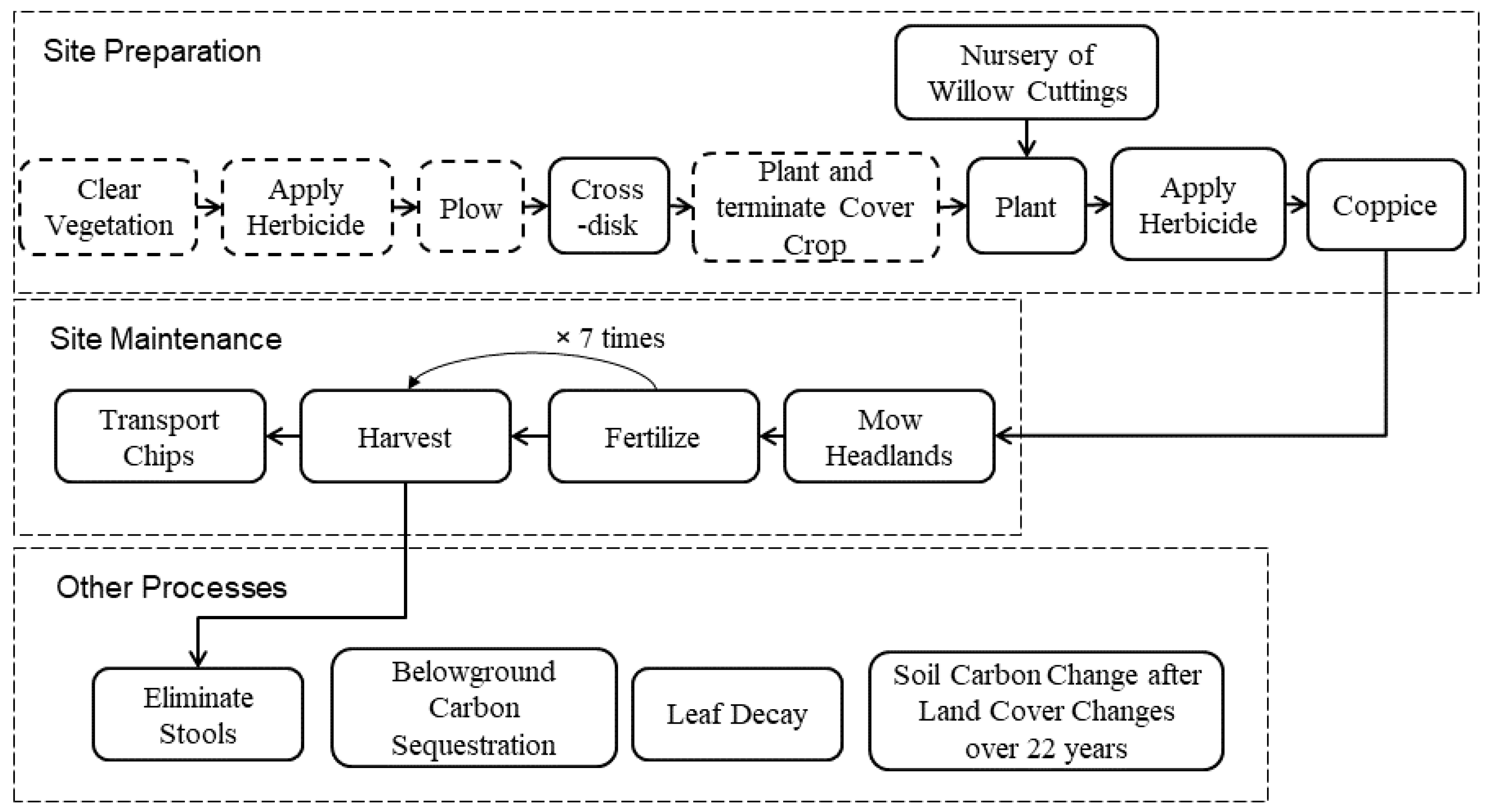
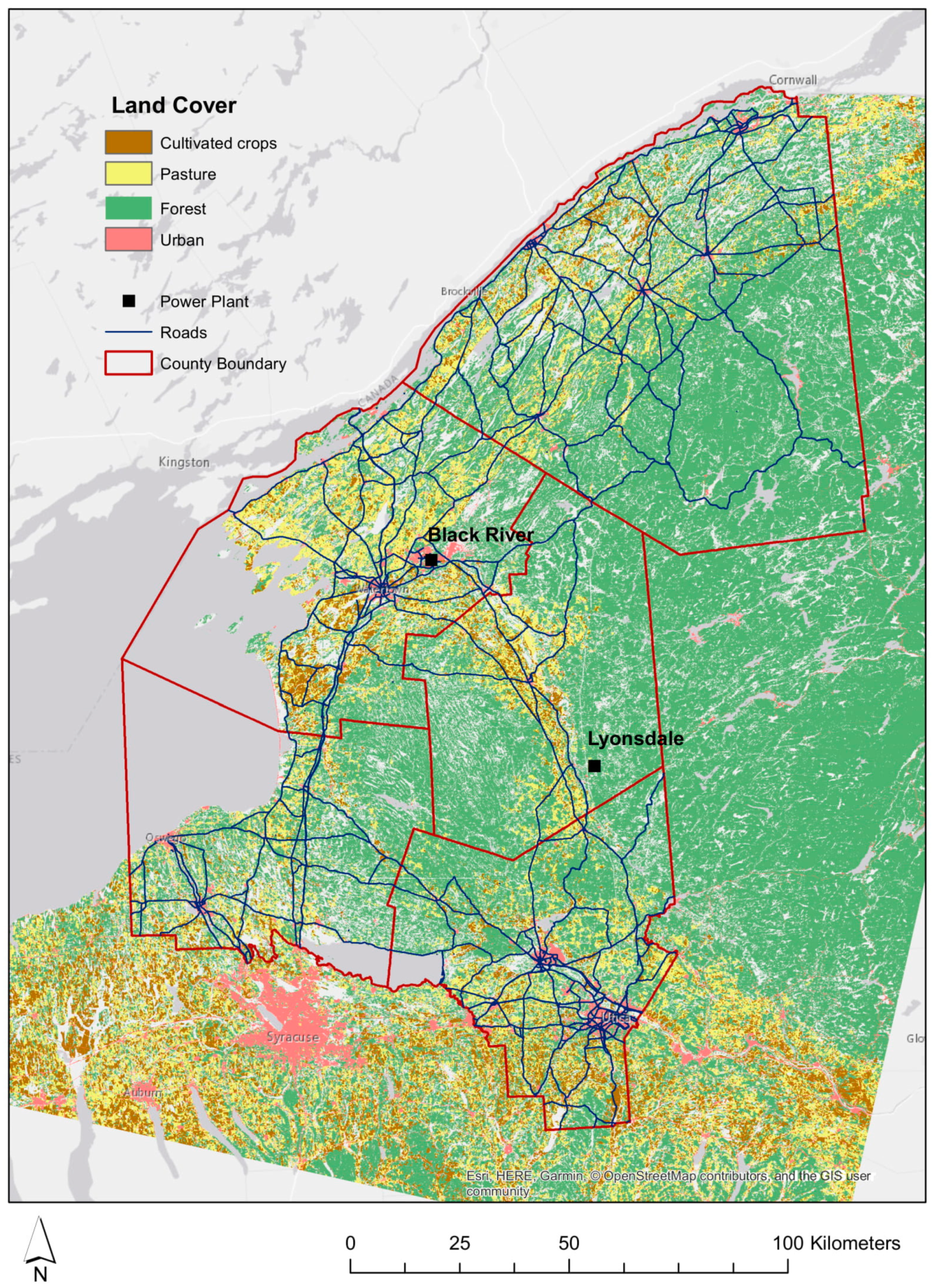
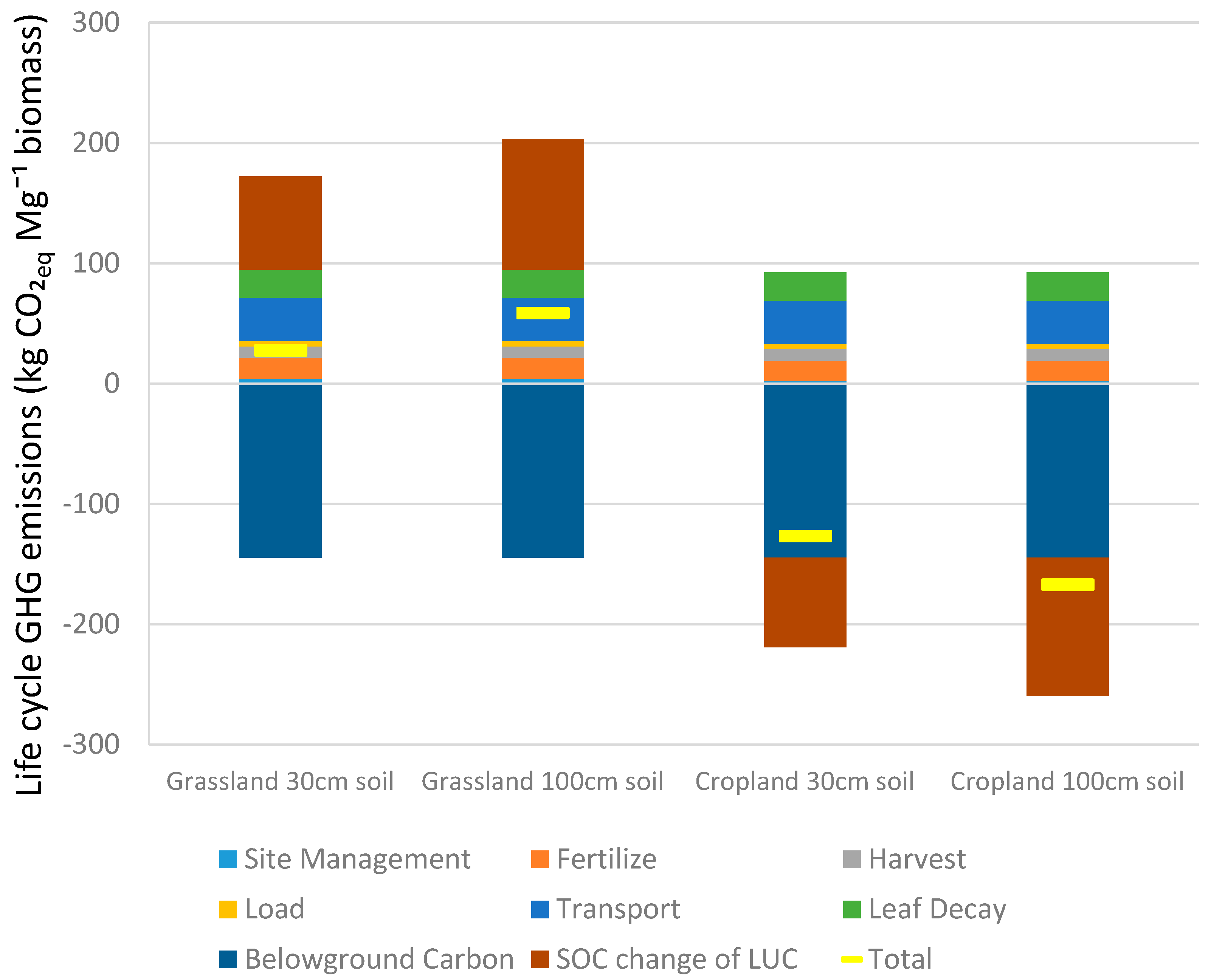
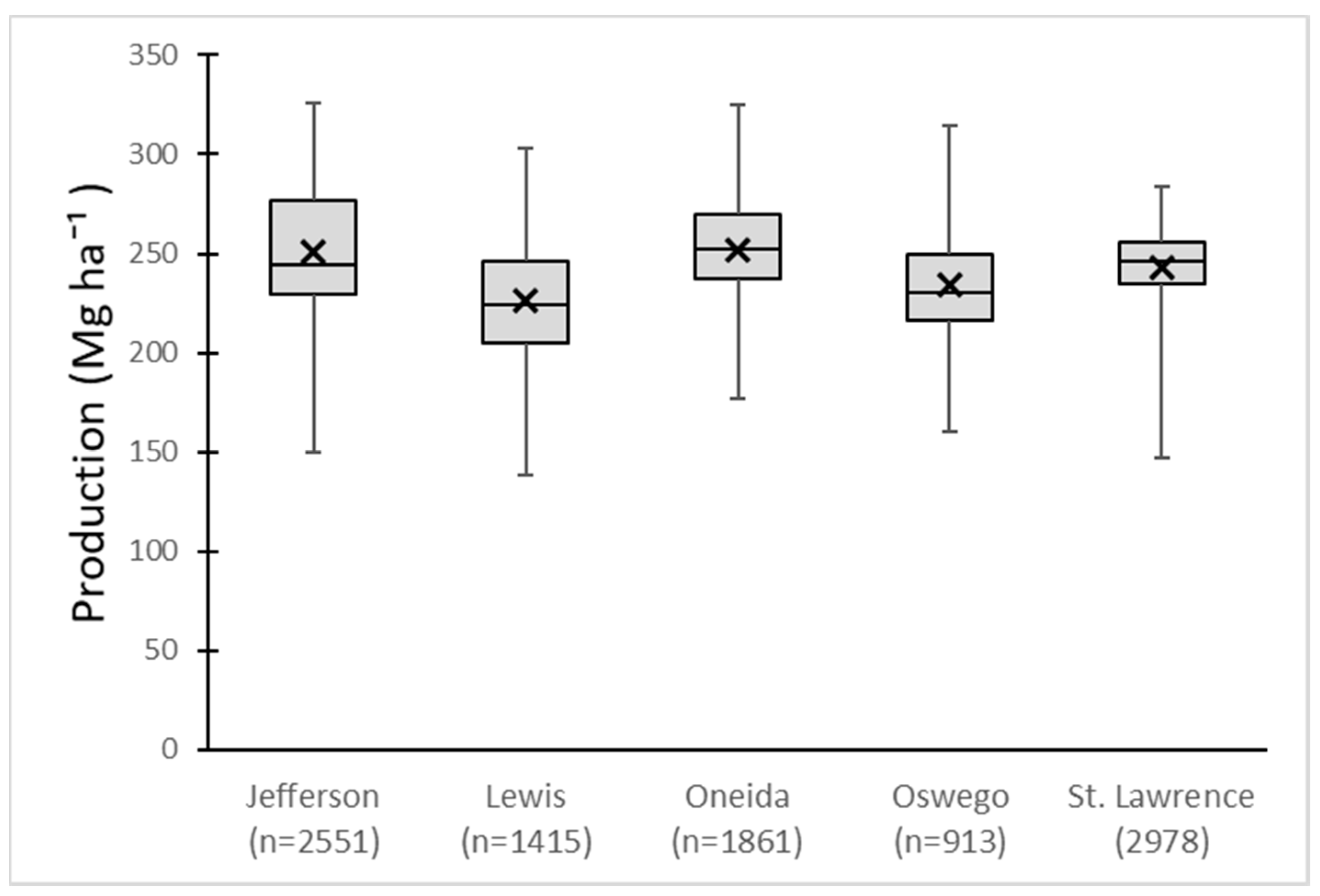
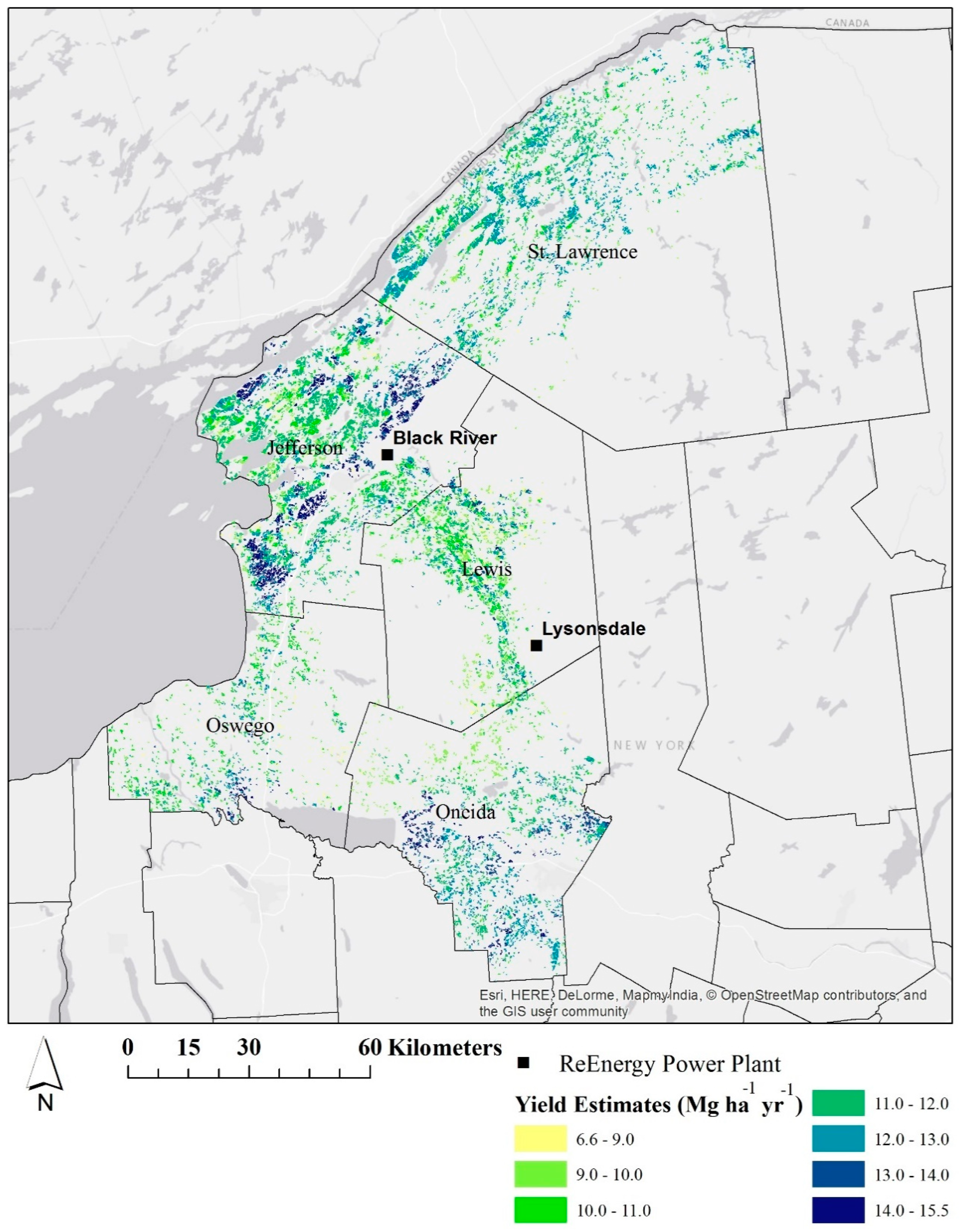
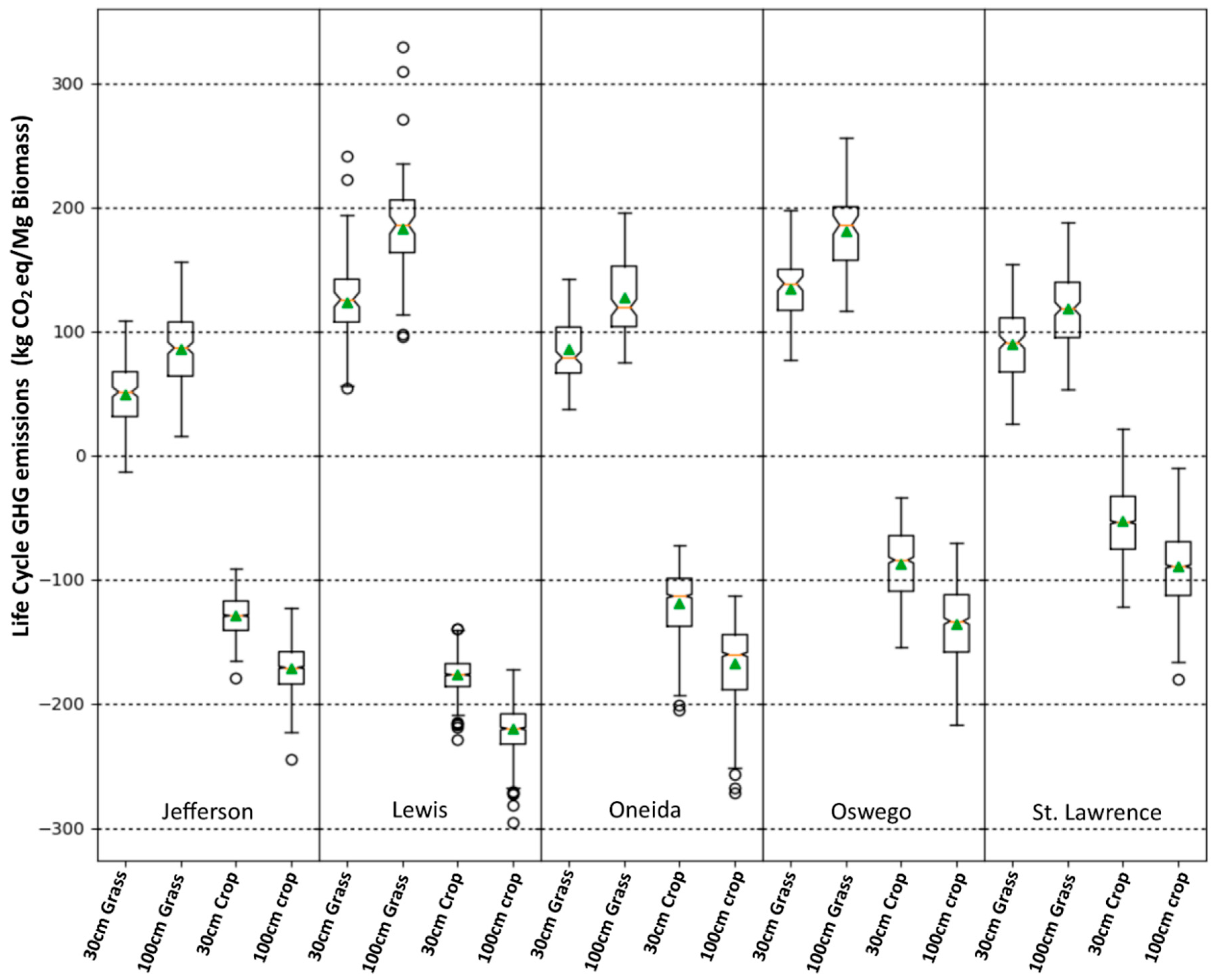
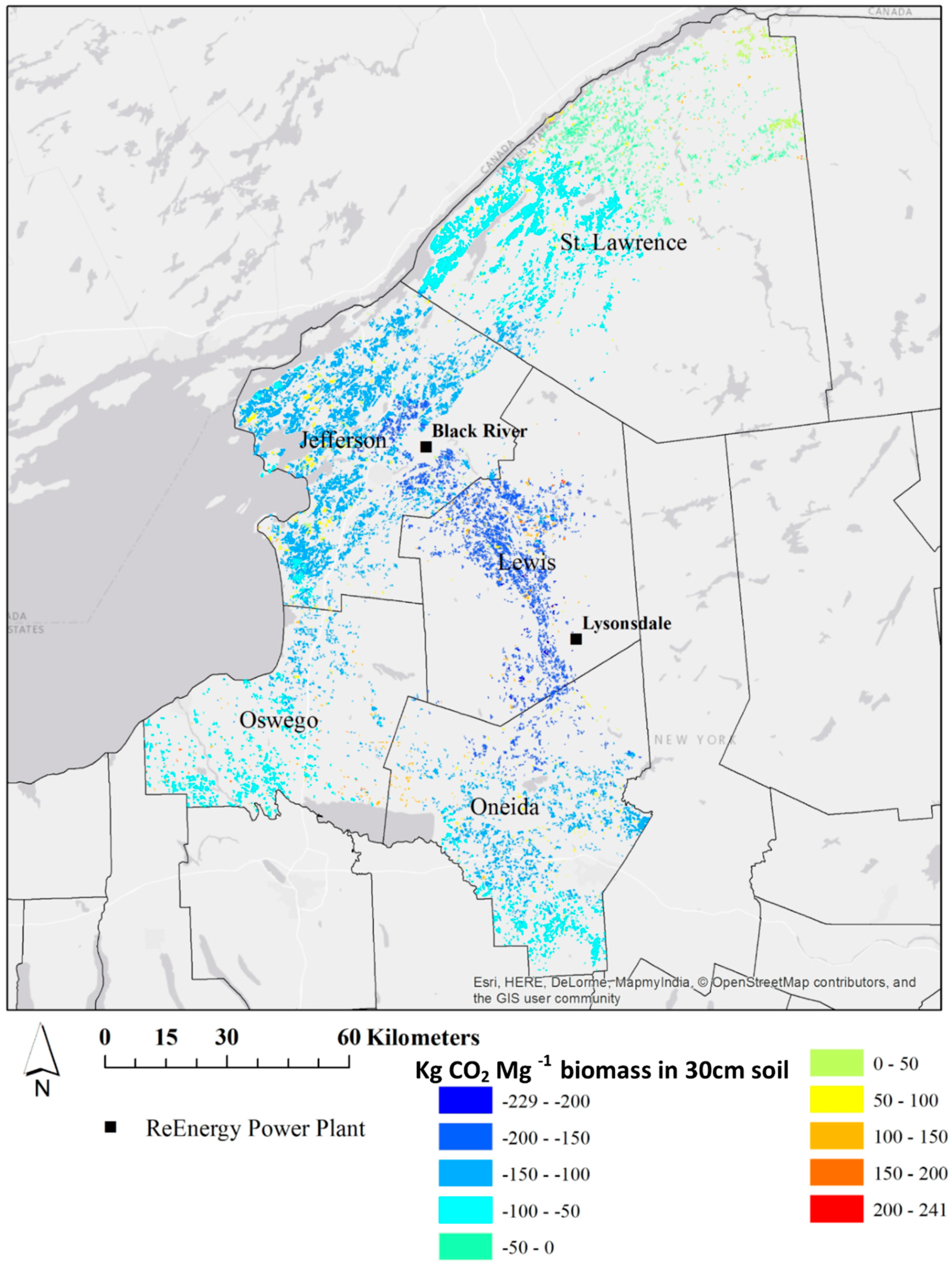
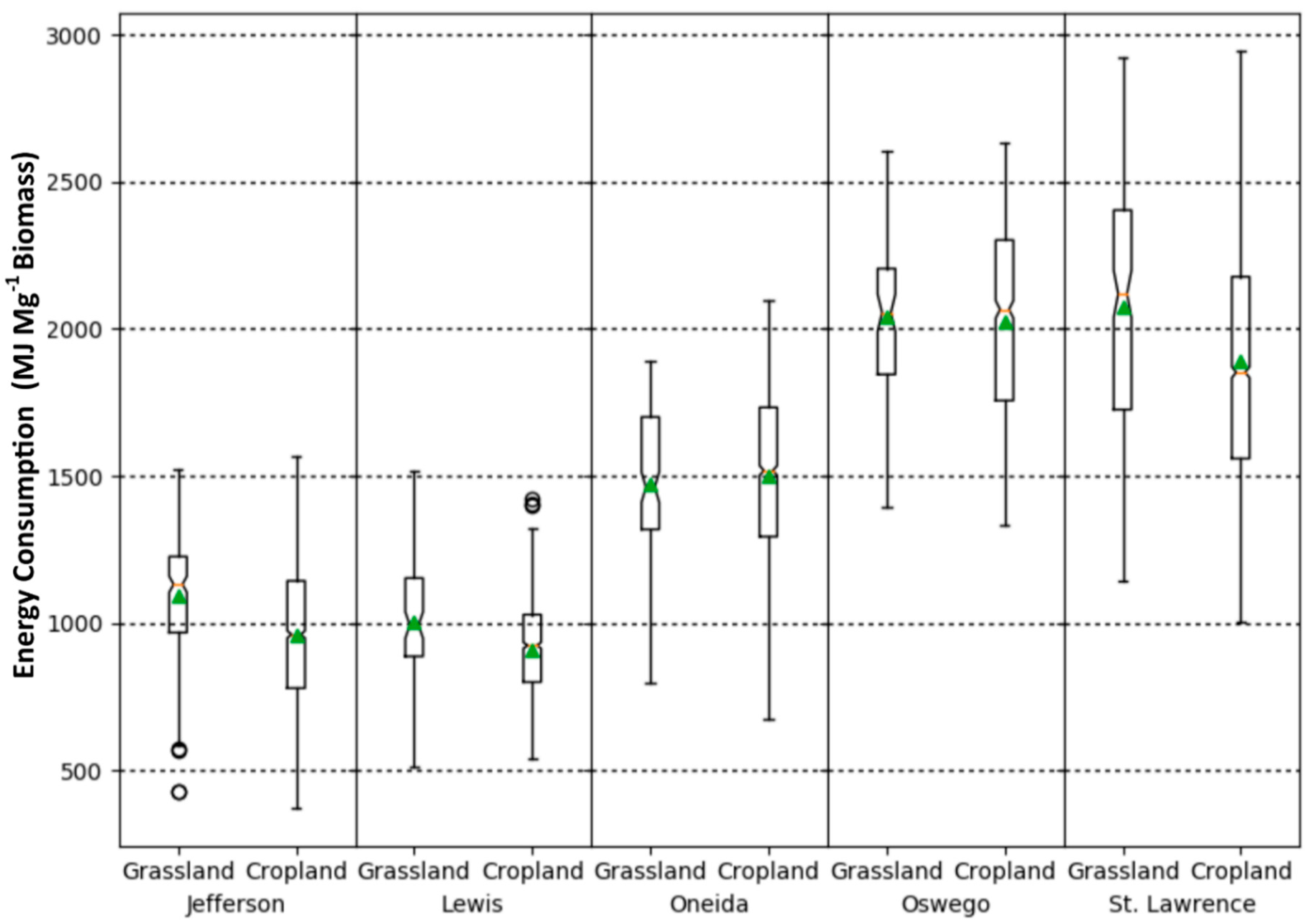
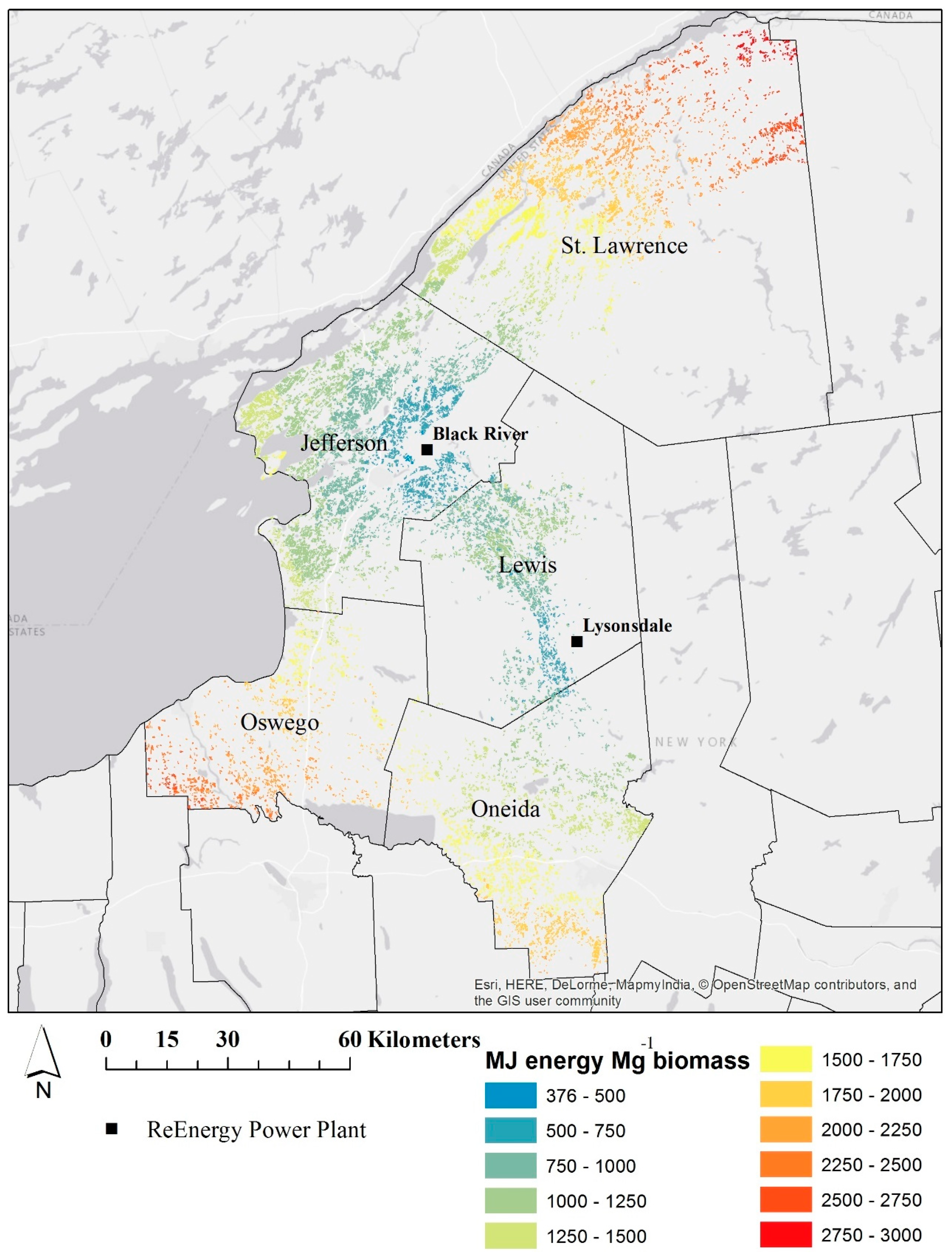
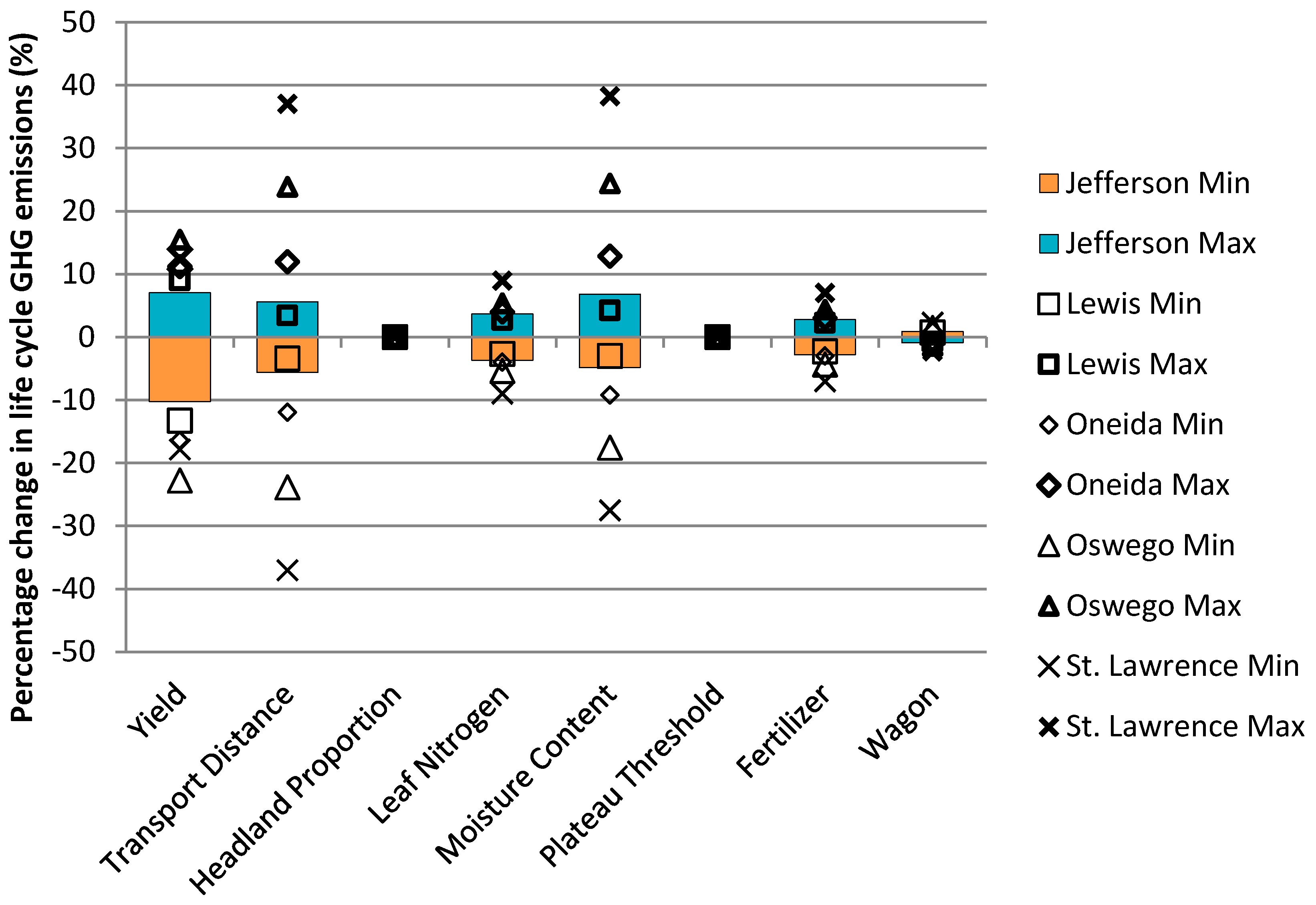
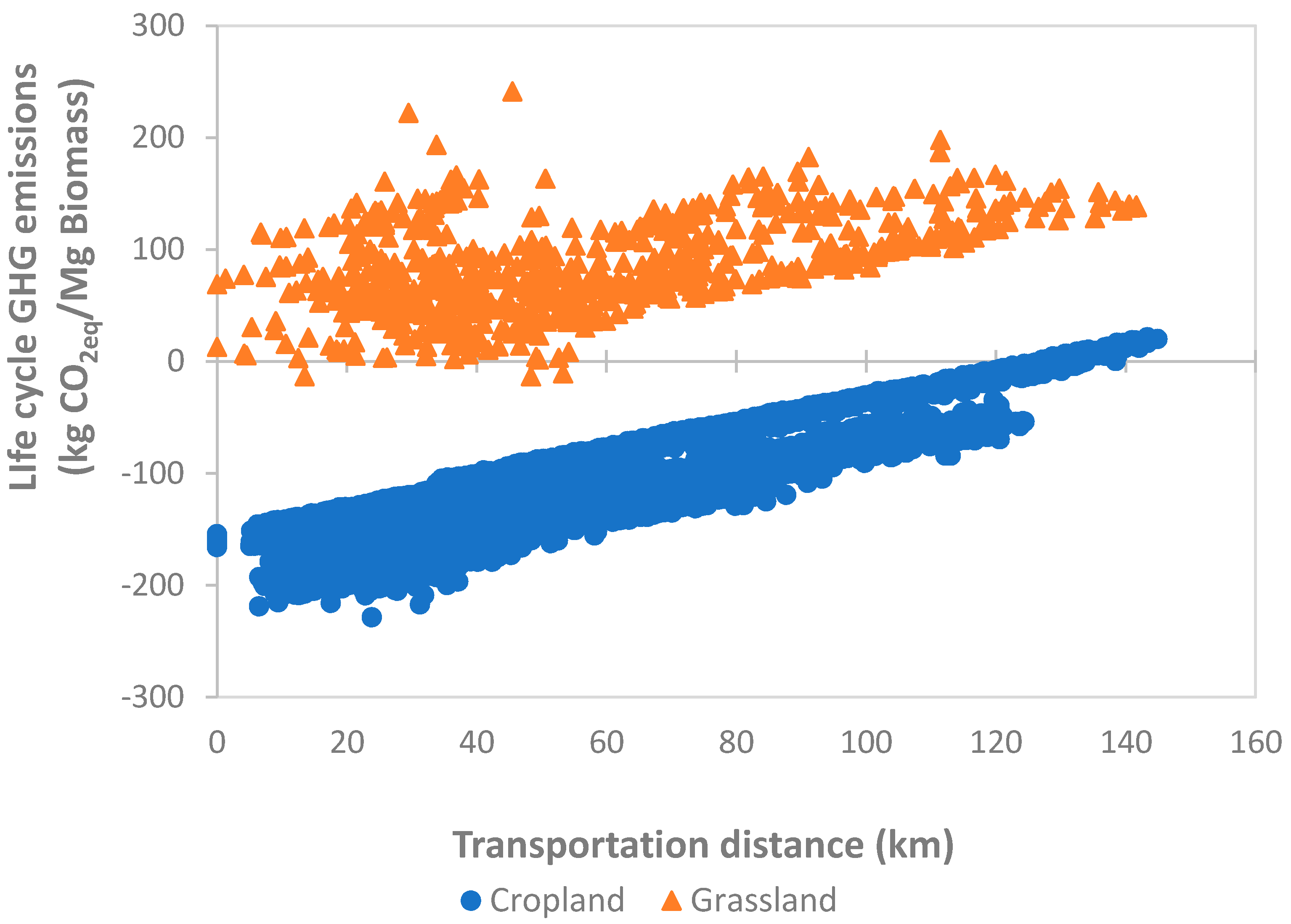
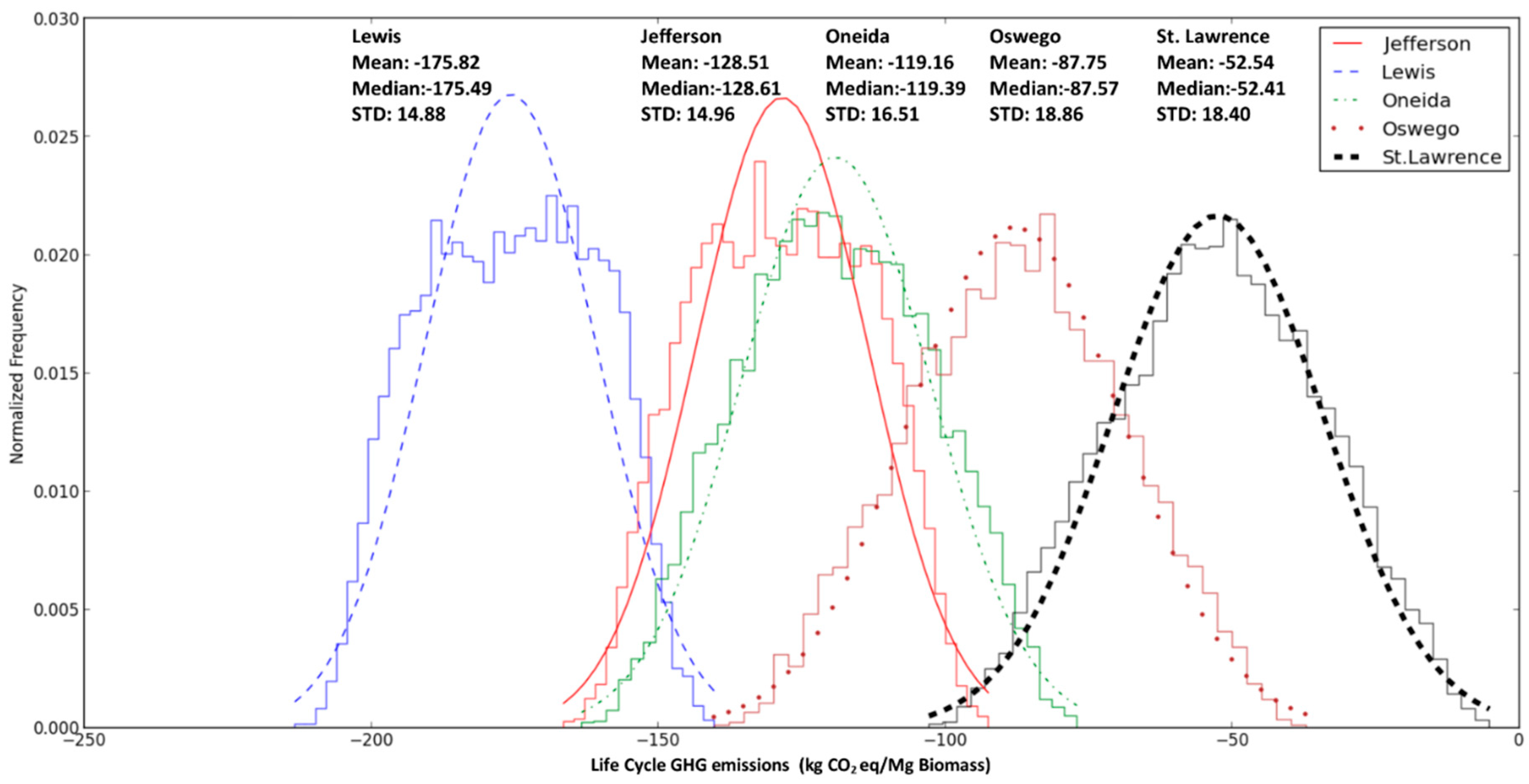
| Parameter | Minimum | Baseline | Maximum |
|---|---|---|---|
| Yield (Mg ha−1) 1 | 225.1 | 260.3 | 295.65 |
| Headland (as % of total land) | 8% | 10% | 12% |
| Urea fertilizer (kg ha−1) | 89.68 | 112.1 | 134.5 |
| Wagons with tractor (field−1) | 1 | 2 | 3 |
| Moisture content (%) [27] | 35.2 | 44.0 | 52.8 |
| Leaf nitrogen (%) [28] | 1.85 | 2.32 | 2.78 |
| Threshold harvesting rate (ha h−1) 2 | 1.40 | 1.75 | 2.10 |
| Transport distance Jefferson (km) 3 | 4 | 31 | 65 |
| Transport distance Lewis (km) | 1 | 26 | 52 |
| Transport distance Oneida (km) | 13 | 62 | 95 |
| Transport distance Oswego (km) | 53 | 90 | 124 |
| Transport distance Oswego (km) | 34 | 84 | 145 |
| Data | Data Source | Spatial Resolution | Source |
|---|---|---|---|
| Land use cover | National Land Cover Database (NLCD) | 30 m | [34] |
| SOC change associated with land use change | Carbon Calculator for Land Use Change from Biofuels Production (CCLUB) | County | [20,21,33] |
| Soils data used for parcel selection and NCCPI index for yield estimates 1 | Soil Survey Geographical Database (SSURGO) | 10 m | https://datagateway.nrcs.usda.gov/ |
| County | SOC Annual Change Rate (Mg C ha−1 yr−1) | |||
|---|---|---|---|---|
| 30 cm Soil Cropland | 30 cm Soil Grassland | 100 cm Soil Cropland | 100 cm Soil Grassland | |
| Jefferson | 0.24 | −0.25 | 0.37 | −0.35 |
| Lewis | 0.34 | −0.43 | 0.46 | −0.58 |
| Oneida | 0.32 | −0.29 | 0.47 | −0.41 |
| Oswego | 0.31 | −0.29 | 0.45 | −0.41 |
| St. Lawrence | 0.19 | −0.19 | 0.30 | −0.27 |
© 2020 by the authors. Licensee MDPI, Basel, Switzerland. This article is an open access article distributed under the terms and conditions of the Creative Commons Attribution (CC BY) license (http://creativecommons.org/licenses/by/4.0/).
Share and Cite
Yang, S.; Volk, T.A.; Fortier, M.-O.P. Willow Biomass Crops Are a Carbon Negative or Low-Carbon Feedstock Depending on Prior Land Use and Transportation Distances to End Users. Energies 2020, 13, 4251. https://doi.org/10.3390/en13164251
Yang S, Volk TA, Fortier M-OP. Willow Biomass Crops Are a Carbon Negative or Low-Carbon Feedstock Depending on Prior Land Use and Transportation Distances to End Users. Energies. 2020; 13(16):4251. https://doi.org/10.3390/en13164251
Chicago/Turabian StyleYang, Sheng, Timothy A. Volk, and Marie-Odile P. Fortier. 2020. "Willow Biomass Crops Are a Carbon Negative or Low-Carbon Feedstock Depending on Prior Land Use and Transportation Distances to End Users" Energies 13, no. 16: 4251. https://doi.org/10.3390/en13164251
APA StyleYang, S., Volk, T. A., & Fortier, M.-O. P. (2020). Willow Biomass Crops Are a Carbon Negative or Low-Carbon Feedstock Depending on Prior Land Use and Transportation Distances to End Users. Energies, 13(16), 4251. https://doi.org/10.3390/en13164251





